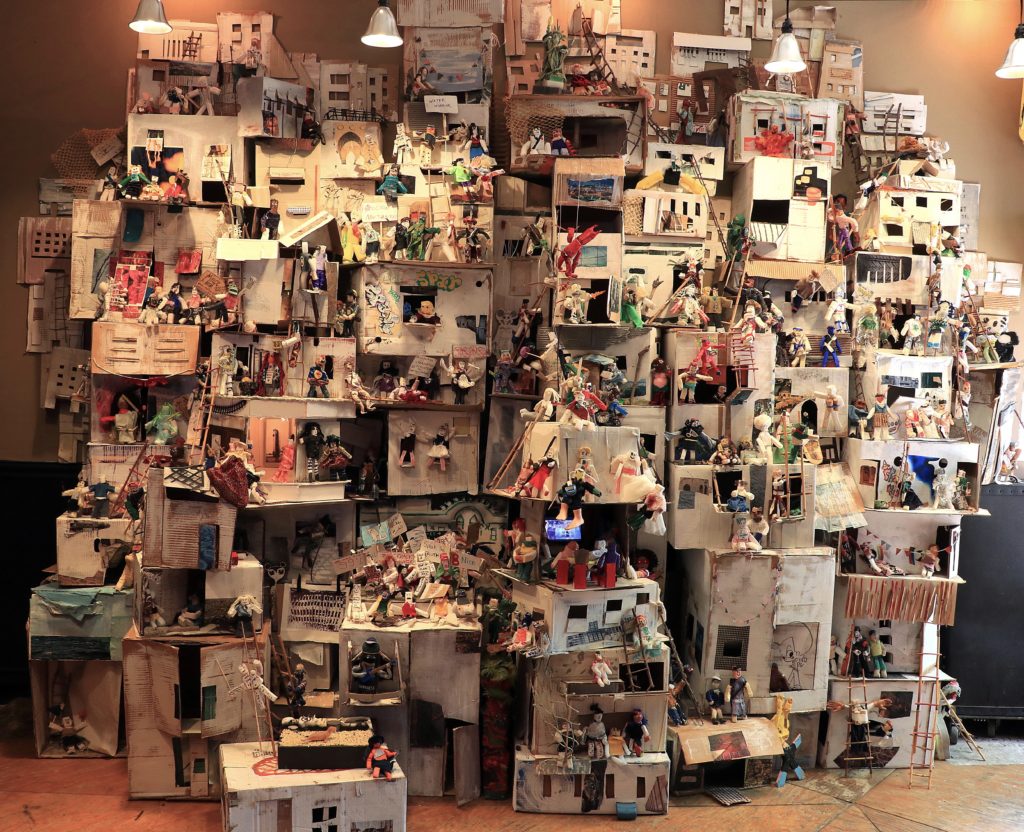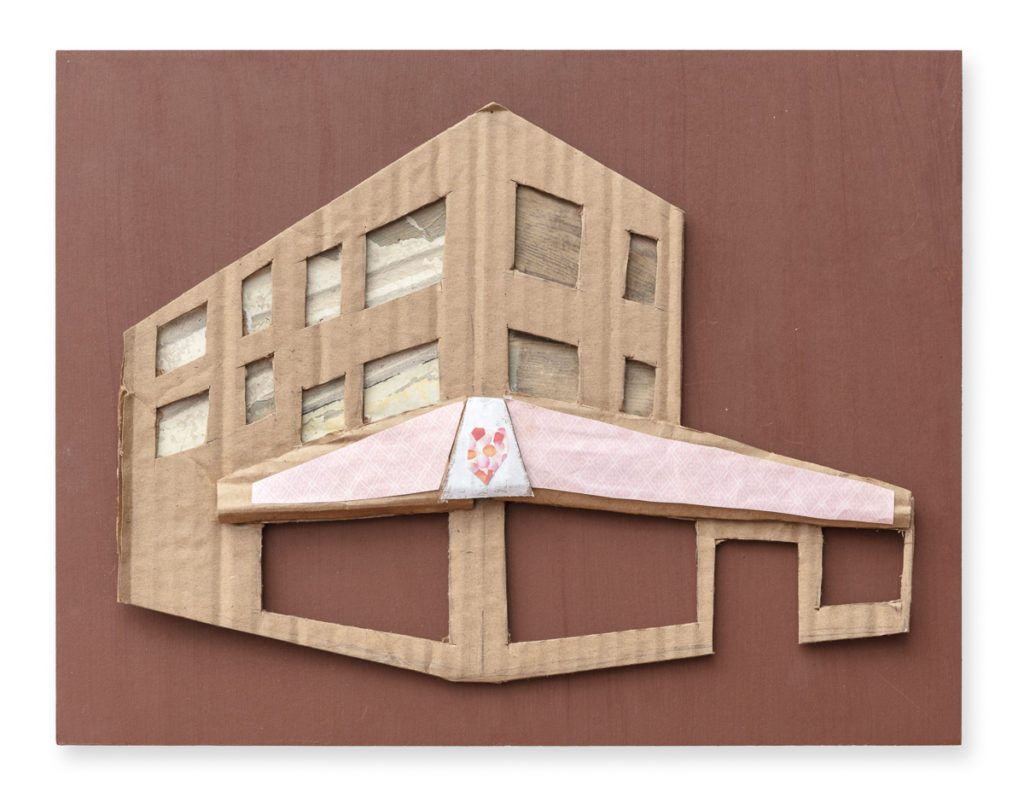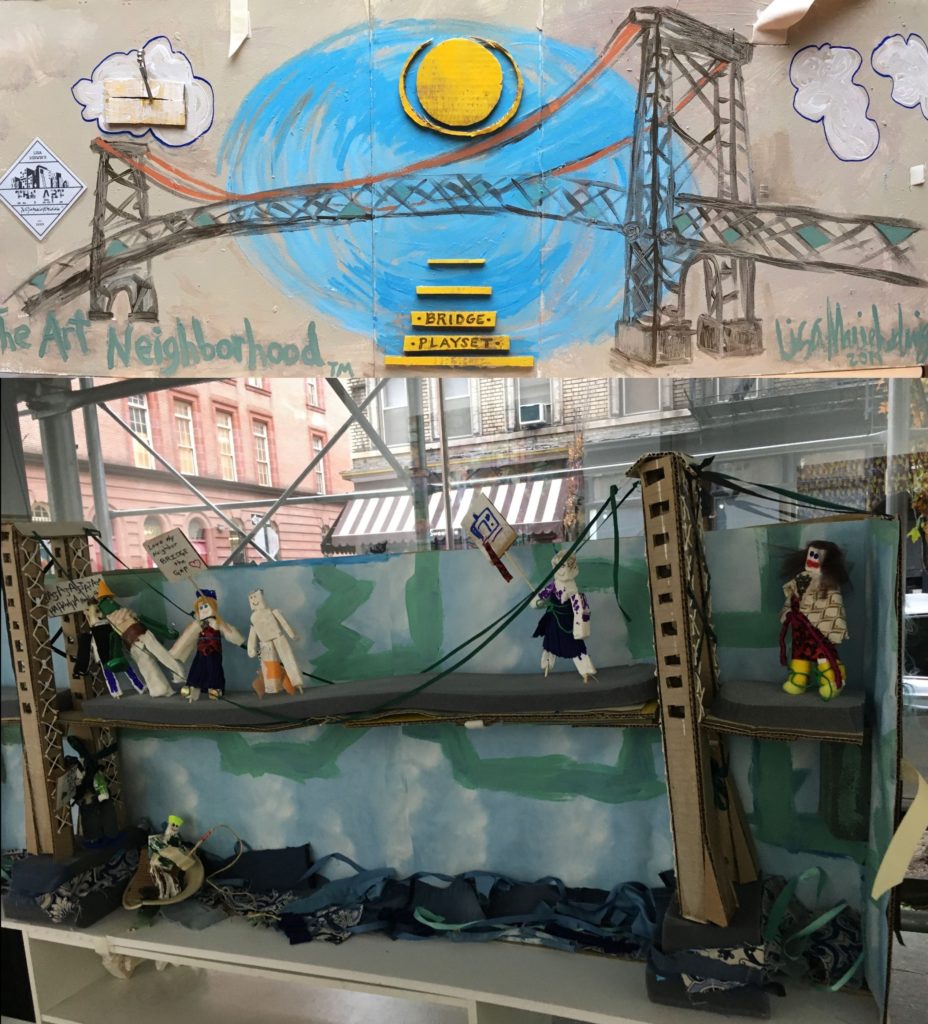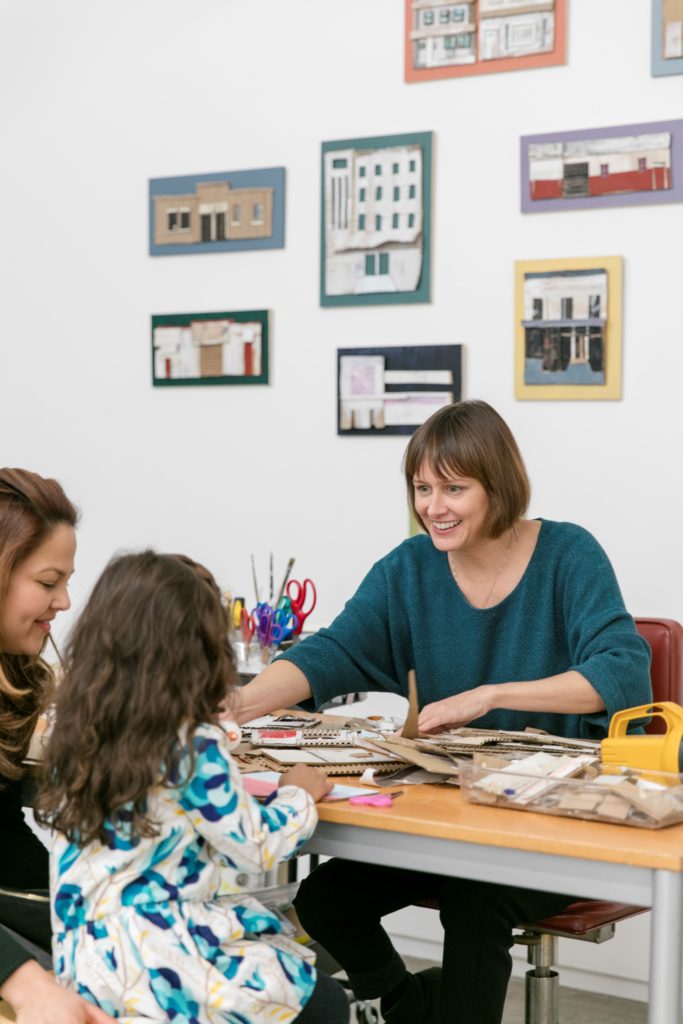Blog Archive, Great Reads
An Artist’s Perspective on the Tenement Museum: Lisa Marie Ludwig
February 19, 2020

Lisa Marie Ludwig- The Art Neighborhood
In this blog post series, Lead Educator Marina Bardash Nebro will explore artist perspectives on the Tenement Museum. In this edition, she invited Lisa Marie Ludwig, a local New York City artist working primarily with maquettes (small models), to visit the Tenement Museum and reflect on her experience. She attended our Shop Life tour, featuring the Schneider Family’s 19th century saloon and apartment, as well as the stories of other commercial businesses that operated out of 97 Orchard Street throughout its history. How can an artistic perspective broaden our understanding of history? Take a look at our interview, and perhaps find inspiration in your next visit! (Featured image: Lisa Marie Ludwig, The Art Neighborhood, Installation View at The City Reliquary)

Lisa Marie Ludwig, Facade Project, 180 Bedford Ave, Brooklyn, NY
What were some of the highlights during your experience taking the Shop Life tour?
I really liked the exterior of the building, and by going in, essentially, I was going back in time. I loved that experience – the storytelling, being inside a maquette of an original space, all the details. Learning about this being Little Germany was really neat. I am probably over 50% German, and so I was like, ‘This is my history too, that’s weird!’ I was really excited about that. All of a sudden, it’s encroaching on my story. I wasn’t expecting that.
And the way community works. I like thinking about how you might have a small bedroom, but then you run into the bier hall or the pub, and that’s your living room! That’s where you’re gonna meet with all your friends, it sounds beautiful. I feel like we’re not living like that to our fullest anymore. Community-wise, we’re all separated, cut-off. We didn’t get to explore all these rooms [in 97 Orchard Street], but I was just like ‘wow,’ thinking about how community, especially in New York City and urban environments, is stacked. Story after story after story – this is one teeny story.
And learning about politics. From legislation and the blue laws closing down the bier halls, to the women in the Jewish communities protesting the hike on their kosher meats. Also, getting rid of the carts. I was in New York when they got rid of other types of carts… that was devastating, they hiked the price for licenses or something, and that was really sad to see. But I guess that’s going on continuously.
The stories behind the façade really spoke to me.
Why would you recommend the Tenement Museum as a place to visit?
It just got me excited about community, and how sometimes coming together you can make changes. If people don’t know about it, or know the possibilities, then they can’t want it. By people coming here… I think it just makes you more aware. There is all this life behind each façade you pass by, like tons of stories. It makes you feel like you’re a part of it. And I think that’s what I want my work to do too, and I feel like the Tenement Museum does that.
What are the biggest takeaways from your Tenement Museum experience?
This specific tour kind of made me feel like I wanted to dig deeper into the façades I’ve created. By coming to a museum like this helps me to gain vocabulary to talk about my art. I’m really inspired to engage on a different level with my work. I try to be involved in my community, it’s really important, but it made me see that there are other layers and other ways to go about it. It made me want to revisit that, and revisit my participation in my community, and see what more I can do. It was really inspiring.
Tell me a little bit about your artwork and how it connects to the themes you discovered at the Tenement Museum!
The Façade Project is an ongoing artwork that records and documents building that are being torn down in my neighborhood of Williamsburg, Brooklyn. Every day, another building was being torn down – without warning, or a mourning period, without a chance to say goodbye they were simply and suddenly vanishing. The cultural landscape of New York City has been steadily shifting, but now even the architectural landscape is disappearing. I wanted other people to know, and not forget, these changes. Right now, I have over 150 small cardboard relief sculptures of the buildings. Now I’m trying to get record of people telling me stories of the buildings, records from the city for each one, because they no longer exist.
Before The Art Neighborhood, I was creating playsets of real moments. For example, I might make a maquette of my tour at the Tenement Museum – with the other visitors, the tour guide, the props – and it would be like a toy. I then got the opportunity to have a show in Williamsburg, based on this playset idea, but I wanted to make it of my world – all the people I knew, and was meeting – I wanted a record of that. I saw this as another documentation of time and place. And at the time, Hurricane Katrina had just happened and people were being displaced all over the country. People were living in shantytown communities, and emergency buildings, and I started thinking about the world. Why aren’t we living in a better world? The Art Neighborhood, by getting people to participate in the artwork – thinking about what you would bring into a community, what is the best part of them – has given me hope.
I’m just trying to have a conversation, and to give people space to do that.
You’ve recently shown your artwork in the Lower East Side. Do you have any particular connection to this neighborhood?
One of my recent exhibitions was with the Art and Social Activism Festival, and the other was doing a workshop at the Front Room Gallery (around the corner from the Tenement Museum). They are both social activist exercises for me. I’m learning as an artist that it’s important for me to practice social activism, and the way I do it is through art and by giving people tools so they can also participate. By doing the Façade Project at the Art and Social Activism Festival, I was bringing forward the conversation of changing communities (as the Lower East Side is seeing today), equality, and living. We all have rights to live a certain way without it costing all of our paycheck. And then I did a workshop at the Front Room Gallery. I created a Williamsburg Bridge diorama playset. Front Room came from Williamsburg, and they were pushed out, and they ended up here in the East Side. So, the Williamsburg Bridge is actually a literal bridge, but it also represents “bridging the gap,” bridging ideas together. I really believe that we should all be working together on change. I had people make figures of themselves and make signs of anything they wanted to talk about right now. We’re in a climate of activism, where people are heavy hearted and they have something they want to say. I wanted to create something that didn’t have to be a specific topic – economic, religion, ethics. It could span any topic, and the bridge symbolized that.

Lisa Marie Ludwig, Williamsburg Bridge Playset, Front Room Gallery
I feel like there is a connection between Williamsburg and the Lower East Side. I would come over here for the culture, and I would live over there for the prices. The Lower East Side was the place to be if you wanted to learn about music, art, literature, and poetry. That’s the reason I moved to New York. But Williamsburg was a cheaper place to live at that time – I could have a studio, and work over there, for nothing. That was my New York – the Lower East Side and Williamsburg.
I migrated here from North Carolina. I came here because I wanted this community, I wanted culture, I wanted art, I wanted people from all places of the world. I wanted to learn their stories. I wanted it to change who I am, and it has. It makes me want to fight for people who don’t have a voice, to maintain a vibrant community that can offer others some opportunity I found upon coming to the city. And it makes me want to try to help in any way I can with the tools that I have.

Artist Lisa Marie Ludwig
by Tenement Museum Educator Marina Bardash Nebro